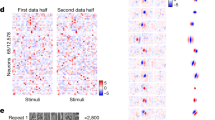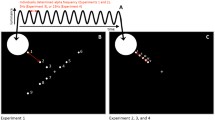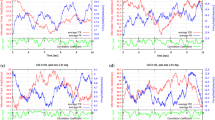Abstract
We show that coherent oscillations among neighboring ganglion cells in a retinal model encode global topological properties, such as size, that cannot be deduced unambiguously from their local, time-averaged firing rates. Whereas ganglion cells may fire similar numbers of spikes in response to both small and large spots, only large spots evoke coherent high frequency oscillations, potentially allowing downstream neurons to infer global stimulus properties from their local afferents. To determine whether such information might be extracted over physiologically realistic spatial and temporal scales, we analyzed artificial spike trains whose oscillatory correlations were similar to those measured experimentally. Oscillatory power in the upper gamma band, extracted on single-trials from multi-unit spike trains, supported good to excellent size discrimination between small and large spots, with performance improving as the number of cells and/or duration of the analysis window was increased. By using Poisson distributed spikes to normalize the firing rate across stimulus conditions, we further found that coincidence detection, or synchrony, yielded substantially poorer performance on identical size discrimination tasks. To determine whether size encoding depended on contiguity independent of object shape, we examined the total oscillatory activity across the entire model retina in response to random binary images. As the ON-pixel probability crossed the percolation threshold, which marks the sudden emergence of large connected clusters, the total gamma-band activity exhibited a sharp transition, a phenomena that may be experimentally observable. Finally, a reanalysis of previously published oscillatory responses from cat ganglion cells revealed size encoding consistent with that predicted by the retinal model.
Similar content being viewed by others
References
Alonso JM, Usrey WM, Reid RC (2001) Rules of connectivity between geniculate cells and simple cells in cat primary visual cortex. J Neurosci 21:4002–4015
Ariel M, Daw NW, Rader RK (1983) Rhythmicity in rabbit retinal ganglion cell responses. Vis Res 23:1485–1493
Cohen E, Sterling P (1990) Convergence and divergence of cones onto bipolar cells in the central area of cat retina. Philos Trans R Soc Lond Ser B Biol Sci 330:323–328
Dacey DM, Brace S (1992) A coupled network for parasol but not midget ganglion cells in the primate retina. Vis Neurosci 9:279–290
De Carli F, Narici L, Canovaro P, Carozzo S, Agazzi E, Sannita WG (2001) Stimulus- and frequency-specific oscillatory mass responses to visual stimulation in man. Clin Electroencephalogr 32:145–151
Doiron B, Chacron MJ, Maler L, Longtin A, Bastian J (2003) Inhibitory feedback required for network oscillatory responses to communication but not prey stimuli. Nature 421:539–543
Duda RO, Hart PE, Stork DG (2001) Pattern classification. Wiley, New York
Freed MA (2000) Rate of quantal excitation to a retinal ganglion cell evoked by sensory input. J Neurophysiol 83:2956–2966
Friedrich RW, Habermann CJ, Laurent G (2004) Multiplexing using synchrony in the zebrafish olfactory bulb. Nat Neurosci 7:862–871
Frishman LJ, Saszik S, Harwerth RS, Viswanathan S, Li Y, Smith EL III, Robson JG, Barnes G (2000) Effects of experimental glaucoma in macaques on the multifocal ERG. Multifocal ERG in laser-induced glaucoma. Doc Ophthalmol 100:231–251
Grimmett G (1999) Percolation. Springer, Berlin Heidelberg New York
Hoshen J, Kopelman R (1976) Percolation and cluster distribution. I. cluster multiple labeling technique and critical concentration algorithm. Phys Rev B 14:3438–3445
Ishikane H, Gangi M, Honda S, Tachibana M (2005) Synchronized retinal oscillations encode essential information for escape behavior in frogs. Nat Neurosci 8:1087–1095
Ishikane H, Kawana A, Tachibana M (1999) Short- and long-range synchronous activities in dimming detectors of the frog retina. Vis Neurosci 16:1001–1014
Jacoby R, Stafford D, Kouyama N, Marshak D (1996) Synaptic inputs to ON parasol ganglion cells in the primate retina. J Neurosci 16:8041–8056
Kenyon GT, Harvey NR, Stephens GJ, Theiler J (2004a) Dynamic segmentation of gray-scale images in a computer model of the mammalian retina. In: Tescher AG (ed). Proceedings of SPIE: applications of digital image processing XXVII. Denver 5558: 1–12
Kenyon GT, Marshak DW (1998) Gap junctions with amacrine cells provide a feedback pathway for ganglion cells within the retina. Proc R Soc Lond B Biol Sci 265:919–925
Kenyon GT, Moore B, Jeffs J, Denning KS, Stephens GJ, Travis BJ, George JS, Theiler J, Marshak DW (2003) A model of high-frequency oscillatory potentials in retinal ganglion cells. Vis Neurosci 20:465–480
Kenyon GT, Theiler J, George JS, Travis BJ, Marshak DW (2004b) Correlated firing improves stimulus discrimination in a retinal model. Neural Comput 16:2261–2291
Kenyon GT, Travis BJ, Theiler J, George JS, Stephens GJ, Marshak DW (2004c) Stimulus-specific oscillations in a retinal model. IEEE Trans Neural Netw 15:1083–1091
Laufer M, Verzeano M (1967) Periodic activity in the visual system of the cat. Vision Res 7:215–229
Martinez-Conde S, Macknik SL, Hubel DH (2004) The role of fixational eye movements in visual perception. Nat Rev Neurosci 5:229–240
Meister M, Berry MJ II (1999) The neural code of the retina. Neuron 22:435–450
Miller JA, Denning KS, Geroge JS, Marshak DW, Kenyon GT (2006) A high frequency resonance in the responses of retinal ganglion cells to rapidly modulated stimuli: A computer model. Vis Neurosci 23(5) (in press)
Neuenschwander S, Castelo-Branco M, Singer W (1999) Synchronous oscillations in the cat retina. Vis Res 39:2485–2497
Neuenschwander S, Singer W (1996) Long-range synchronization of oscillatory light responses in the cat retina and lateral geniculate nucleus. Nature 379:728–732
Nirenberg S, Carcieri SM, Jacobs AL, Latham PE (2001) Retinal ganglion cells act largely as independent encoders. Nature 411:698–701
O’Brien BJ, Isayama T, Richardson R, Berson DM (2002) Intrinsic physiological properties of cat retinal ganglion cells. J Physiol 538:787–802
Schnitzer MJ, Meister M (2003) Multineuronal firing patterns in the signal from eye to brain. Neuron 37:499–511
Shadlen MN, Movshon JA (1999) Synchrony unbound: a critical evaluation of the temporal binding hypothesis. Neuron 24:67–77, 111–125
Shadlen MN, Newsome WT (1998) The variable discharge of cortical neurons: implications for connectivity, computation, and information coding. J Neurosci 18:3870–3896
Singer W, Gray CM (1995) Visual feature integration and the temporal correlation hypothesis. Ann Rev Neurosci 18:555–586
Steinberg RH (1966) Oscillatory activity in the optic tract of cat and light adaptation. J Neurophysiol 29:139–156
Stephens GS, Neuenschwander S, George JS, Theiler J, Marshak DW, Singer W, Kenyon GT (2003) See globally, spike locally: retinal oscillations encode large contiguous features. In: Society for Neuroscience Abstracts.
Usrey WM, Reppas JB, Reid RC (1999) Specificity and strength of retinogeniculate connections. J Neurophysiol 82:3527–3540
Vaney DI (1990) The mosaic of amacrine cells in the mammalian retina. In: Osborne NN, Chader GJ (eds)Progress in retinal research. Pergamon Press, Oxford, pp 49–100
Vaney DI (1994) Patterns of neuronal coupling in the retina. Prog Retin Eye Res 13:301–355
Wachtmeister L (1998) Oscillatory potentials in the retina: what do they reveal. Prog Retin Eye Res 17:485–521
Wachtmeister L, Dowling JE (1978) The oscillatory potentials of the mudpuppy retina. Invest Ophthalmol Vis Sci 17:1176–1188
Author information
Authors and Affiliations
Corresponding author
Rights and permissions
About this article
Cite this article
Stephens, G.J., Neuenschwander, S., George, J.S. et al. See globally, spike locally: oscillations in a retinal model encode large visual features. Biol Cybern 95, 327–348 (2006). https://doi.org/10.1007/s00422-006-0093-5
Received:
Accepted:
Published:
Issue Date:
DOI: https://doi.org/10.1007/s00422-006-0093-5




